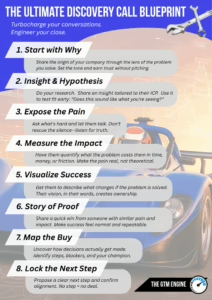People like to buy—but they hate to be sold.
That truth is what makes a discovery call fail before they even start.
Instead of a conversation, reps run through a checklist. Instead of uncovering motivation, they manufacture pain. And instead of guiding buyers, they push them—right into silence or objections.
But it doesn’t have to be that way.
This article breaks down an 8-step Discovery Call Blueprint designed to flip the script. It’s built for B2B sales teams who want to qualify hard, build trust fast, and never sound like a walking pitch deck again. You’ll see how this approach borrows from the best frameworks—MEDDPICC, SPICED, Challenger—but improves them by putting the buyer in control of a conversation engineered for insight and action.
If you’re a founder, AE, or sales leader who wants a repeatable process that actually feels human, this guide is your roadmap.
Additional resource: If you want this blueprint codified into your team’s process, start with a simple sales playbook that reps can follow and coach to. See what should go into a sales playbook.
Quick Answers: Discovery Call Basics
(New to discovery calls? Start here.)
What is a discovery call in sales?
A discovery call is a structured conversation where a salesperson uncovers a prospect’s goals, challenges, and buying process to determine fit.
What makes a good discovery call?
A great discovery call builds trust, uncovers pain, quantifies impact, and sets clear next steps—without turning into a scripted interrogation.
What is the best structure for a discovery call?
The most effective discovery calls follow a blueprint: build rapport, offer insight, uncover pain, measure impact, visualize success, share proof, understand buying, and lock next steps.
Why You Need a Blueprint (Not a Script)
Scripts are for actors. You’re here to solve real problems—not win an Oscar.
The traditional discovery call script tries to protect reps by telling them exactly what to say. But in real conversations, no prospect follows your script. They interrupt. They jump ahead. They go silent. They bring up things you weren’t ready for. That’s why rigid scripts lead to robotic conversations, shallow qualification, and stalled deals.
Instead, top reps use blueprints—structured, flexible systems designed to guide, not control. A blueprint gives you the freedom to adapt while ensuring you don’t miss critical checkpoints like pain, impact, buying process, and next steps.
🧠 Why Discovery Call Blueprints Work: Psychology in Play
One of the key reasons buyers open up—or shut down—comes down to a cognitive phenomenon called the Illusion of Control Bias.
This bias refers to our tendency to overestimate how much control we have over outcomes, especially in uncertain environments. When people feel like they’re choosing their own path—even if it’s subtly guided—they’re more likely to engage, commit, and feel confident in their decisions.
That’s why rigid scripts backfire. They trigger resistance. Buyers feel like they’re being dragged down someone else’s funnel.
A blueprint, on the other hand, creates the experience of choice and flow—while still keeping the rep in control of the structure. It’s like setting guardrails on a racetrack: the buyer drives, but you designed the course.
Sales teams that use a formal sales methodology see an average win rate that’s 11% higher than those that don’t.
—Johnny Grow Sales Methodology Research
1. 🔥Start with Why
Set the tone. Make it human. Earn trust without pitching.
Most reps blast into discovery like TSA agents: verify the name, run through a list of questions, and hope nothing goes wrong.
High-performing reps do something very different in those first minutes:
They explain why their company exists—through the lens of the buyer’s world and shared pain.
❌ “We help companies manage projects.”
✅ “We kept hearing founders say, ‘Our team’s drowning in tasks and we don’t know what’s getting done.’ So we built something to fix that.”
This approach builds instant credibility and signals empathy—without sounding salesy.
🧠 The Psychology Behind It
Storytelling—especially when framed around shared pain—activates emotional engagement and trust-building pathways in the brain. According to psychology research on self-disclosure and narrative framing, people are more likely to open up when the other party leads with vulnerability or relatability.
It’s the opposite of “show up and throw up.” Instead, you’re inviting the prospect into a conversation rooted in why this matters to both of you.
Humans are hardwired for stories: facts are 22× more likely to be remembered when wrapped in a story, and data retention jumps from 5–10% to 65–70% with narrative context. (10 Storytelling Statistics: A Must-Know For Marketers in 2024)
This moment isn’t explicitly called out in most frameworks. But it underpins everything else.
Before you uncover pain, ask about impact, or share a win story—you need trust. This is how you earn it without sounding like a rep who’s “just checking boxes.”
2. 🔍 Insight & Hypothesis
Share a sharp, ICP-focused insight—and let them either nod or correct it.
After setting the tone with your “Why,” bring in a focused insight about your Ideal Customer Profile (ICP)—and anchor it in a pain + impact combo you’ve heard across that segment.
“When we talk to growth-stage SaaS teams with lean RevOps, they’re usually drowning in personalization tasks—burning hours just trying to customize outbound. It’s a huge drag on pipeline volume and rep productivity. Are you running into anything like that?”
This does two things:
- Seeds the emotional + business cost of inaction—without sounding like a pitch.
- Tests for fit while showing you understand their world.
📊Backed by Data
A Forrester study via Corporate Visions found that “74% of buyers choose the sales rep that first adds value and insight during the sales process.” (B2B Buying Behavior in 2025: 40 Stats and Five Hard Truths That Sales Can’t Ignore)
Positioning yourself as that early value-add dramatically boosts your credibility and differentiates you from reps who simply rattle off generic questions.
🧠 Psychology at Play
This step leverages Confirmation Bias: you give them an anchor about their situation, and they’ll naturally confirm or correct it.
That gives them early control—while you learn whether you’re on the right path. Using their own validation, you continue with confidence, not assumption.
🔄 Framework Comparison
- MEDDPICC checks Metrics and Champion—but often with static formulas.
- Challenger encourages insight-based questioning—but doesn’t ensure it’s tailored.
This Blueprint combines both: ICP-specific insight that’s both relevant and real, without pushing your agenda.
✅ Tip: Before the call, research 2–3 ICP-specific trends or benchmark data points. Present one as your hypothesis. Let their reaction affirm direction.
Great insight lands when it’s anchored to a real ICP. If your ICP is still fuzzy, use this guide: how to figure out your Ideal Customer Profile when you haven’t sold much yet.
Want a faster jumpstart? Run an Out-of-Body Experience session to hear your buyer’s world in their words: the OOBE every founder needs.
3. 🚨 Expose the Pain
Ask the questions that get them talking—then stay quiet and listen.
The moment you break your silence after asking, “What’s the hardest part about this?” is when real insight begins.
Meta-scripted questions = showstopper.
Real curiosity = breakthrough.
📊 Data That Matters
Gong’s analysis of over 519,000 discovery calls found that reps who asked 11–14 targeted questions had a 74% success rate, compared to just 46% for those who asked 1–6 questions. (12 Sales Discovery Questions to Pinpoint Pain)
That surge in win rate isn’t about volume—it’s about quality and depth of questioning.
🧠 Psychological Foundation
Asking layered, open-ended questions triggers self-disclosure, the human tendency to reveal personal thoughts when invited. Paired with silence, you lower resistance and let the prospect lead.
🧩 Blueprint + Framework Connection
This step overlaps with SPICED Pain and MEDDPICC Pain segments—but is different because it’s discovery-led rather than script-led.
It isn’t a checkbox list; it’s an invitation. “Help me understand what gets in your way,” is your cue to listen—and qualify simultaneously.
4. 💥 Measure the Impact
Don’t stop at pain—dig into its cost. Make it financial, operational, and emotional.
Once you uncover a problem, ask:
- “What does that cost you—in time, money, morale?”
- “What happens if it keeps going?”
You want them to quantify the pain. Anchor it in real terms—dollars, wasted hours, customer frustration.
📊 Why It Matters
Discovery without impact quantification is like diagnosing without measuring symptoms. According to Pavilion, “80% of the sales process happens in discovery”—and the first step to turning pain into a compelling business case is quantifying it. (Your #1 Selling Secret in 2022 — Converting Discovery Into a Quantified Pain Statement)
🧠 Psychology at Play
This step triggers loss aversion—the psychological phenomenon where people prefer avoiding losses more than acquiring equivalent gains. Highlighting what they’ll lose if they stay static increases urgency and motivation to change.
🔗 Framework Context
- MEDDPICC Metrics – we’re making that explicit here.
- SPICED Impact – but it’s not a demonstration—it’s their numbers, their story.
✅ Tip: Bring a simple ROI framework, but let them fill in the values. That ownership builds commitment—and moves the deal forward.
5. 🏁 Visualize Success
Seed the opportunity. Let them own the upside.
Most buyers aren’t used to talking about success in vivid terms—especially with a salesperson. That’s why “What would success look like?” usually falls flat.
Instead, listen closely to the pain and its impact, then suggest the likely upside you’ve seen in similar situations. Let them confirm or course-correct.
“In other teams we’ve worked with, solving this helped them cut cycle time by 30% and actually freed up their lead AE to start outbounding again. Would a shift like that move the needle for you too?”
Now they’re not being asked to dream—they’re reacting to a possibility. When they confirm, they start to own the vision. When they correct, they reveal what really matters.
📊 Data That Moves Deals
A recent test from Conversion Rate Experts showed that adding future-pacing visuals nearly doubled demo requests—from UI tweaks alone, not even full messaging changes. (Win Report: How future pacing doubled demos for a SaaS company)
This proves that making success tangible drives action.
🧠 Psychology at Play
This moment blends several core psychological triggers:
Cognitive Dissonance: Once they say the outcome matters, staying in the status quo starts to feel uncomfortable. That’s fuel for urgency.
Future Pacing: Helps the buyer mentally experience the post-solution state, which increases desire and commitment.
Availability Heuristic: Concrete examples make success feel more likely and achievable.
🔗 Blueprint + Framework Comparison
- SPICED “Impact” + “Critical Event” often aim here—but tend to assume buyers can verbalize ROI on the spot.
- This Blueprint approach gives them something to react to, so they don’t have to start from zero.
✅ Tip: Use past client wins to plant vision—always tethered to the pain they already admitted.
6. 📘 Story of Proof
Back your claims with a real, relevant win. Make success feel normal.
Once the buyer sees what’s possible, it’s time to show them someone like them already did it—and won.
But skip the 10-slide case study. The best proof stories are short, sharp, and tailored:
“One of our clients had almost the exact same bottleneck with handoffs between sales and onboarding. After tightening the process, they cut churn by 22% in the first 90 days. They were where you are six months ago.”
You’re not just building credibility—you’re reducing risk. You’re saying: this has been done before, and it worked.
📊 Why It Works
According to a Trust in Advertising report from Nielsen, 92% of buyers trust recommendations and stories about others like them, even from someone they just met. That makes micro-case studies more persuasive than product features or claims alone.
🧠 Psychology at Play
This step activates social proof, one of the most potent persuasion triggers in behavioral psychology. But it also taps into the Bandwagon Effect: when people see others like them making a smart move, they’re more likely to follow.
Also at work:
- Storytelling neuroscience: stories engage more areas of the brain than facts alone, increasing memory and emotional connection.
- Risk reduction bias: when a solution feels tested and de-risked, the decision becomes easier to justify internally.
🔗 Framework Tie-In
Traditional frameworks assume case studies live later in the sales process. This Blueprint brings them into discovery—to reinforce belief while emotion is highest. When done right, it’s the bridge between pain and possibility.
✅ Tip: Your story should mirror their industry, role, or problem. Relevance is more powerful than prestige.
Proof works best when it’s a story, not a spec sheet. For messaging that actually sticks, see Founder storytelling: why human stories outperform feature lists in B2B.
7. 🗺️ Map the Buy
Understand how decisions really happen—and find your champion.
Most deals die quietly—not from indifference, but from overlooked decision paths. Instead of asking “Do you have budget?”, guide the buyer to walk you through their process:
“Curious—when a decision like this gets made, who needs to weigh in and how does it normally flow?”
This uncovers stakeholders, timelines, blockers—and reveals your internal champion who’s willing to push.
📊 Why It Matters
Deals with multiple decision-makers involved early in discovery have 45% higher win rates than single-stakeholder deals—according to ForecastIO’s analysis of thousands of SaaS opportunities (How To Calculate Win Rate in Just a Few Steps)
🧠 Psychology at Play
This step leverages Cognitive Ease: people default to the path of least resistance. By letting them explain their own process, you reduce friction and increase transparency.
It also activates Commitment Consistency—when someone articulates a process or advises involvement, they’re invested in making it happen.
🔗 Framework Comparison
This aligns with the Decision Criteria, Decision Process, Champion pillars in MEDDPICC—but without being a compliance drill.
It’s about discovery, not interrogation.
✅ Tip: Reflect back what they share:
“Okay—so you, Lisa, and maybe Ops need to review, and that usually happens in your monthly leadership meeting?”
Hearing their own words builds clarity and accountability.
8. 🛠️ Lock the Next Step
End the call with clarity—set a mutual action, timeline, and accountability.
Every good call deserves a powerful finish. Rather than saying, “I’ll follow up,” propose something specific and collaborative:
“Based on our conversation, it sounds like there’s a fit and a clear next step could be a follow-up demo with your operations lead next Tuesday. Does that timing work for you?”
This ensures momentum, alignment, and shared ownership—not guesswork.
🧠 Psychology at Play
The Zeigarnik Effect tells us that humans remember and focus on unfinished tasks better than completed ones. Securing a next step taps into this bias—keeping the deal top of mind and driving momentum.
By phrasing it collaboratively—“Does that timing work for you?”—you invite commitment rather than pushing an agenda.
🔗 Framework Comparison
This step mirrors the Timeline focus in SPICED and Paper Process in MEDDPICC—but without the pressure.
It’s not just about moving forward—it’s about mutual movement.
✅ Tip: Recap the conversation’s highlights before locking in the step:
“We’ve identified the fit, quantified the impact, aligned the vision, and know who’s involved. Next, let’s bring in your ops lead next Tuesday at 10 AM—ok?”
🎯 Wrap-Up: Why This Blueprint Works
- Buyer-first structure—puts the prospect in control while maintaining rep-led discipline.
- ** psychology-driven techniques**—leverages control bias, future pacing, social proof, and more to guide without pressure.
- Performance-ready—backed by win-rate-boosting stats and frameworks like MEDDPICC and SPICED, but modernized for conversational impact.
This isn’t just a script—it’s your GTM Engine. A repeatable, scalable system that delivers qualification, connection, and conversion in every call.
✅ What’s Next?
Ready to turn this blueprint into deals?

📥 Download the 1-page Ultimate Discovery Call Blueprint — print it, share it, coach with it.
🎓 Coming soon: The Full GTM Discovery Call Training — a no-fluff, high-impact video series walking through each step in depth.
👉 Will be available at www.revvdup.xyz when it drops.
🤖 In Development: AI-Powered Discovery Call Analyzer — analyze your team’s calls, score performance, and track improvement over time.
(If you want early access, stay tuned or drop your email at Revv’d Up.)
Want a shortcut to GTM clarity?
Download The GTM Engine e-book or Book a free GTM audit discovery call and build a strategy that works—no myths, just results.
If you’re scaling a team around this blueprint, the CCO playbook covers org design, responsibilities, and timing: Chief Commercial Officer guide.
Frequently Asked Questions About Discovery Calls
What is a discovery call in sales?
A discovery call is a structured conversation between a salesperson and a potential customer to determine fit, uncover challenges, and map the buying process. It typically happens early in the sales cycle to qualify opportunities and build trust.
What should a good discovery call include?
A great discovery call includes rapport-building, insight sharing, uncovering pain points, quantifying impact, exploring success outcomes, sharing proof, clarifying the buying process, and agreeing on next steps. It’s a conversation—not an interrogation.
How long should a discovery call last?
Most effective discovery calls last between 25–35 minutes, allowing time for both qualification and relationship-building without overwhelming the prospect.
How do you structure a discovery call?
The best structure is a flexible blueprint that guides the conversation while keeping the buyer in control. The 8-step Discovery Call Blueprint includes:
- Start with Why
- Insight & Hypothesis
- Expose the Pain
- Measure the Impact
- Visualize Success
- Story of Proof
- Map the Buy
- Lock the Next Step
Is MEDDPICC a discovery framework?
MEDDPICC is a full sales qualification framework. It covers metrics, decision process, champions, and more—but it’s often too rigid for early conversations. The Discovery Call Blueprint incorporates the best of MEDDPICC, SPICED, and Challenger—but makes it feel like a human conversation.
Where can I get a discovery call script or checklist?
You can download the free 1-page Ultimate Discovery Call Blueprint as a checklist. A full training program is coming soon at www.revvdup.xyz, along with an AI-powered Discovery Call Analyzer.


Leave a Reply